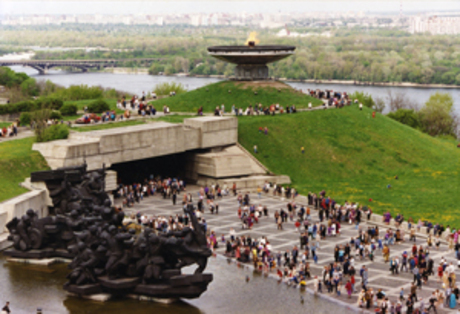War Museum
Dominated by the enormous, towering statue of the Motherland (looking like the sword-wielding sister of the Statue Of Liberty) above it, the Great Patriotic War Museum houses a fascinating collection of World War II artefacts in a Soviet-built building. Decommissioned tanks sit outside the museum, symbolically painted with flowers and nearby, another interesting statue entitled 'To the Fallen' serves as a memorial to all those who fought and died in the war. Although most of the museum notes are in either Russian or Ukrainian, they are well laid out and the displays are fascinating.
In June 1943, in the middle of the battle for liberation of Ukraine, the Republic's government made a decision to create a museum of the Great Patriotic War of the Ukrainian people. However, other priority issues, like reconstruction and development of the economy, postponed the implementation of this decision till 70s of the previous century.
The Republican exhibition named The Guerillas of Ukraine in Their Fight against Fascist German Invaders, opened in 1946, is considered to be one of the main predecessors of the modern museum. At the time of opening, the collection included 13 thousand exhibits. After closure of the exhibition in 1950, its materials were transferred to the exhibits’ depository of the State Historic Museum; in 1970 it hosted a task force with the mission of founding a museum of the war history.
The Ukrainian State Museum of the Great Patriotic War of 1941-1945 was established in commemoration of 30th anniversary of Ukraine's liberation from the Nazi invaders on Pechersk hills in the former Klovsky Palace on 17 October 1974. It immediately drew attention of the public and numerous visitors. It became obvious that scale of the topic and rich collection demand different scientific concept and special premises. The work started to establish Memorial complex named The Ukrainian State Museum of the History of the Great Patriotic War of 1941-1945, which was finally opened on 9 May 1981.
The ceremonial opening of the Memorial complex «The National Museum of the History of the Great Patriotic War of 1941-1945» took place on the Dnipro hills on 9 May 1981. Creative concept and draft design by the famous sculptor Y. Vuchetych and architect Y. Stamo laid the basis for the museum construction.
A team of sculptors and architects from Kyiv and Moscow has accomplished the design work. Hundreds of well-known enterprises, research institutes and establishments from Ukraine and other republics of the former Soviet Union contributed greatly to its foundation.
The museum is the biggest in Ukraine in terms of its size and importance. Its collection, which is permanently replenished, includes more than 300 thousand exhibits. This enables to refresh the main exposition and permanent relic expositions named Tragedy and Valor of Afghanistan and Wars on Foreign Soil, as well as to create numerous annual exhibitions. Nowadays, the Memorial is a leading research, scientific, methodological, cultural and educational center of military history of Ukraine. Over 24 million visitors from almost 200 countries have familiarized themselves with its expositions.
The Memorial occupies the area of 10 hectares and includes the Museum with the monument to Motherland, the main square with valley of hero-cities, sculptural compositions named Fording the Dnipro and Transfer of Weapons, Heroes of the Front and the Rear with bronze high relief compositions, Fire of Glory Cup, Exposition of Fighting Vehicles and Weaponry, as well as separate building with exhibitions of war relics named Tragedy and Valor of Afghanistan and Wars on Foreign Soil. The visitors can explore Li-2 aircraft, Мі-24В helicopter, and МіG-23 jet fighter.
The main exposition block is a three-storey building which is simultaneously a pedestal for Motherland Monument. The Memorial complex is one of the most popular memorials of Ukraine; it represents an integral part of the historic and architectural landscape of Kyiv that attracts Kyivans and guests of the city.
Taking into account the importance of the Memorial Complex as a unique memory sight of the national culture, as well as to preserve its historic and cultural values, the museum was granted National status by a decree of the President of Ukraine dated 21 June 1996. Since then, the museum bears the name of the Memorial complex «The National Museum of the History of the Great Patriotic War of 1941-1945».
The current exposition was established in October 1994 - May 1995. The priority is given to Ukrainian topicality and Ukraine's contribution to the victory over Nazism. A great deal of attention is paid to other sectors of Soviet-German front, large-scale battles of World War II, creation and activity of Anti-Hitler Coalition, and to heroism and sacrifices of the nation.
The main exposition including 15 thousand museum exhibits is laid out in 16 halls with the total area of 5 thousand square meters. The exposition is featured by its symbols and images created with the aid of genuine easily perceived and remembered historic materials. The exposition of all halls is united around pivotal idea called The Road of War.
The topical war relics expositions, laid out in a separate building, are the integral part of the Memorial complex. Tragedy and Valor of Afghanistan exposition is laid out in two halls, where over 4 thousand exhibits are displayed. Numerous photos, documents, personal belongings, letters, posters and newspapers reproduce the political situation in the world and the USSR in 1979-1989, and give an opportunity to appreciate the faithfulness to military duty, valor and heroism of ordinary combatants of this unannounced war as well as its tragic aftermath. The exposition names and eternally commemorates each of over 3 thousand Ukrainians that perished in the line of duty in Afghanistan.
Wars on Foreign Soil exposition is dedicated to the Soviet people who participated in local wars and armed conflicts fighting outside the USSR in Europe, Asia, Latin America, Middle East and on African continent. The exposition includes over 800 exhibits.




